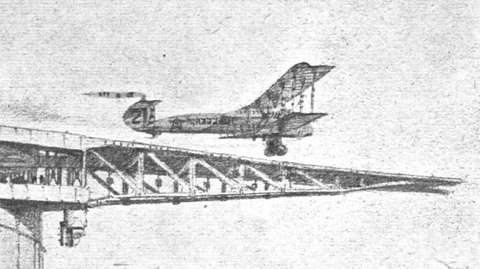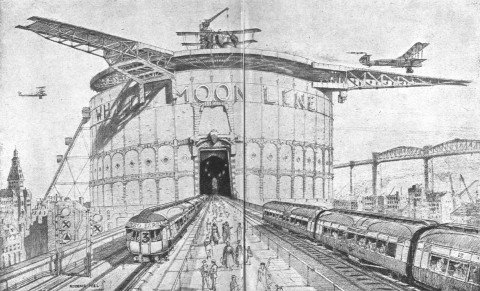TRAVELLING OF THE FUTURE: THE BRITISH AERIAL TERMINUS OF THE WHITE MOON LINE — The old order is passing. Already glimpses of the future of aerial transport, with all its mighty possibilities, are becoming visible. When the stricken nations return to a state of prosperity, great things are in store. As to what economic and commercial revolutions are latent in the development of flying, the most daring of us hesitates to speculate. The picture shows an aerial terminus of the White Moon Line, raised aloft over a seaport. This is no flat aerodrome, but a huge circular structure. Around its topmost circumference platforms swinging on a circular railed bed are carried by two rotating arms, on which the aero liners alight and from which they ascend. The arms are moved round as the wind changes, so that the aero liners descend and ascend facing it. These arms are inclined a little downwards to bring the liners more quickly to rest — they alight up the slope — and to assist them to gather speed more rapidly before the final breathless abandonment of the sloping platform and the upward rush into the heavens. On the left is seen a passenger lift with two cars which rise and sink continually, carrying passengers to and from the high embarking level. A mono-railway penetrates to the heart of the terminus; a footway runs between the tracks. An aero liner is seen just ascending, bound on some far journey; another is stationary, loading up. Inside the structure is a huge lift for lowering the aero liners for refitting and repair, and in its mysterious depths we can picture workshops lit by flickering arc lamps, where hundreds of mechanics work busily day and night… Perhaps some of the future aerial termini will be on the ground; but where a man can find no ground near the starting point, he will raise structures such as this. The sea-captains will look upwards at the air-captains, beholding the fulfilment of a great dream, dreamt by generations of wise men long passed away, who wondered because they knew that such great things would come to pass. From the original by Roderic Hill.
Source: Flight, 6 January 1921, 10–1.

According to Peter Bowler (following David Edgerton), ‘the classic image of aviation promoted in the interwar years [in Britain] was that of the futuristic airliner, not the bomber’.1 I disagree; based on my own research, images like the above were markedly less common than more warlike ones. But this is admittedly just an impression, and could be due to a bias in my research methods. Whether civil aircraft or military ones dominated the projection of aviation is just the sort of question which could in principle be settled in a quantitative manner.
![]() This work is licensed under a Creative Commons Attribution-NonCommercial-NoDerivatives 4.0 International License.
Permissions beyond the scope of this license may be available at http://airminded.org/copyright/.
This work is licensed under a Creative Commons Attribution-NonCommercial-NoDerivatives 4.0 International License.
Permissions beyond the scope of this license may be available at http://airminded.org/copyright/.
- Peter J. Bowler, Science for All: The Popularization of Science in Early Twentieth-Century Britain (Chicago and London: University of Chicago Press, 2009), 57. [↩]






There’s a pic of a similar, but fixed and cruciform roof-mounted aerodrome on top of King’s Cross in Barker and Hyde’s ‘London as it Might Have Been.’
One wonders if the author(s) of this piece had ever piloted an aircraft. This contraption combines the worst features of the aircraft carrier and the mountain-top airfield, and adds the endangerment of the civilians living beneath the behemoth.
Chris:
Yes, I have that book (and should read it one day…). I thought that John Ptak had posted the image on his blog somewhere but I must have been thinking of this post which has some similar proposals.
John:
I agree it’s a pretty absurd design. How much power would it take to rotate that thing anyway? How often would it break down? But in fact Roderic Hill was a pilot: he had flown with the RFC over the Western Front. At this point in his career he was a squadron leader and Officer Commanding of the RAE’s Experimental Section at Farnborough. He ended up an Air Chief Marshal. So I think we have to take it as a serious idea, even if a silly one (if you see what I mean).
Hi Chris, I thought exactly the same myself – I first saw the image when it was used in a lecture on Airport design at University – there’s another image of it which is new to me here;
http://www.gettyimages.co.uk/detail/3435247/Hulton-Archive
This is classic steampunk design. Thinking of an analogy it reminds me of the nuclear powered airliners I used to see drawn in childrens’ science text books when I was young.
Well, Christopher, this will take you back!
*boggles*
Everyone focusses on the negatives. No-one speaks for the positives. Specifically, it would be awesome cool if it worked.
I think that this might also work as a universal rationale for humanitarian interventions in civil wars. And a lot of other things.
Yr nuke-fan man from Cranfield does have a university with (a) its own runway and (b) a Lightning parked at one end of it, so he can be forgiven the odd flight of fancy.
Having a Lightning (English Electric / BAC, I take it?) parked on a runway is nothing. A couple of miles up the road from here a man had one parked in his garden for several months.
Never did find out why. Perhaps he was intending to build a steam powered turntable to fly it from, but couldn’t get the idea past West Oxfordshire’s notoriously cautious planning authority. Perhaps cladding it in Cotswold stone would have cost too much.
If ever I get round to releasing my debut album, it’s going to be called ‘English Electric Stoneclad Lightning’ and it will include a massive acknowledgement to Neil Datson.
He does have impressive credentials, including a stint as president of RAeS, which makes how he could propose such a lunatic idea all the more mysterious. Perhaps it was more of a modest proposal than a serious one, to make people sit up and realise that air travel is going to have to change drastically, one way or another.
Thanks – in anticipation – for the ‘massive acknowledgement’ Chris. Just so long as you don’t expect me to perform on it.
Pingback: The great air-liner of the future – Airminded